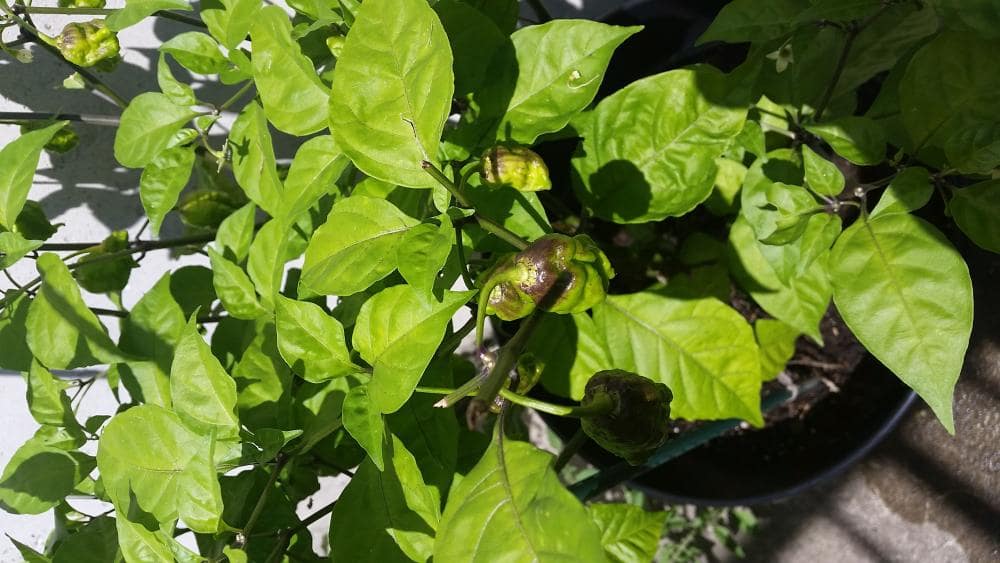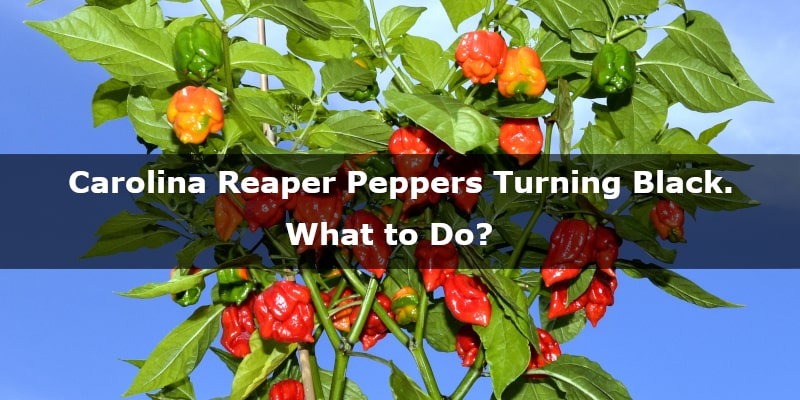You must have heard the name of Carolina Reaper peppers if you are a gardening enthusiast. They are considered one of the hottest and spiciest peppers.
If you are growing Carolina Reaper peppers, you must have come across an issue where the peppers start turning black. Here is what it means.
Why are Carolina Reaper Peppers Turning Black and What to Do About it?
Carolina Reaper peppers turn black due to several reasons. It can be a result of a natural ripening process or some disease. If the blackish hue results from the ripening process, you don’t need to worry about it. However, if it’s due to disease, it is better to remove the diseased pepper from the plants as soon as possible.
Does Carolina Reaper Pepper Turning Black Mean it Has a Disease?
If Carolina Reaper peppers are turning black, there are two primary reasons behind it. One of them is the disease. You must examine the pepper’s texture to identify if it’s a disease. If the Carolina Reaper pepper turns soft and black, it has a disease.
However, in some cases, the Carolina Reaper peppers turn black or show a purplish hue while they are in the process of ripening. As long as they are not soft, the change in their color is normal. It doesn’t alter their flavor, and using them is safe.
3 Reasons That Can Cause Carolina Reaper Peppers to Turn Black
Significant reasons why your Carolina Reaper peppers are turning black besides the natural ripening process might be high sun exposure, blossom end rot, or a result of interaction with pests.
1. Sunscald; High Sun Exposure
A prime cause why your Carolina Reaper peppers are turning black is high sun exposure. Peppers usually require a shady environment to grow. Also, this shady environment is generally provided by the pepper plant’s leaves.
Sometimes, the peppers grow in a direction that doesn’t come under the shade of leaves. Consequently, high sun exposure leads to the incorporation of a blackish hue. However, the pepper must be in high sun exposure for more than 24 hours to show the symptoms of sunscald.
Fun Fact: Similar to high sun exposure, cold temperature can also result in discoloration of Carolina Reaper peppers.
In the picture below, you can see how the Carolina Reaper Peppers look when they’re overexposed to the sun.

2. Blossom End Rot; Lack of Calcium Uptake
Another significant reason Carolina Reaper peppers turn black is when the pepper plant doesn’t uptake enough calcium from the soil because of insufficient watering.
If the duration between watering is too long, the draining capacity of the soil is affected. Consequently, the pepper plant cannot extract calcium from the soil and undergoes calcium deficiency.
Blossom end rot results in soft brownish-black spots, mainly on the lower side of the peppers. Though the healthy part of the pepper after cutting the affected end is safe to eat, it can affect other peppers in contact.
Blossom end rot is likely to happen if the season has just started, as this disease mainly targets the few first-developed fruits and vegetables.
3. Result of Interaction With Pests
Pests are an important reason why your Carolina Reaper peppers are turning black. If your Carolina Reaper peppers are affected by pests, the black color would appear in the form of spots. Also, most of the time, you can spot the presence of pests.
Pests or insects which attack Carolina Reaper peppers infect the peppers with their larvae. The larvae use peppers as their food and shelter source. Consequently, the peppers turn black. Common pests found to be the reason behind infecting Carolina Reaper peppers are,
- Slugs
- Grasshoppers
- Flea beetles
- Aphids
- Cutworms
Other than pests and insects, the black spots on Carolina Reaper peppers can also result from bacterial infection. If you encounter any such symptom on a pepper, separate it from other peppers immediately, as it can infect others.
Tip: Use gloves for any interaction with diseased Carolina Reaper peppers, especially pest-infected ones.
How to Tell if the Black Spots on a Carolina Reaper Pepper is a Natural Process?
If the Carolina Reaper pepper has black spots that are spreading, but the texture is fine, it means the ripening has started. It is a natural process. However, if the pepper is turning black and soft simultaneously, it probably means it has a disease.
There is a specific phase in the ripening process of the peppers where they change their color, and most of the peppers turn black. So, most of the time, when Carolina Reaper peppers turn black, the ripening process has begun.
However, to avoid mixing the ripening process with some diseases, knowing the difference between both possibilities is better.
How Long Will the Black Spots Last on a Carolina Reaper Pepper?
If the black spots on the Carolina Reaper pepper result from the natural process, it probably means the ripening has started. The ripening of Carolina Reaper peppers takes almost 100 days. So, you must wait nearly three months until the pepper has fully ripped.
The ripening process of Carolina Reaper pepper is comparatively larger than other pepper varieties. It is because they are relatively hotter.
However, if the black spots are due to any disease, they will last and expand until you find a solution for them.
What to Do if the Dark Spot on Carolina Reaper Pepper Means a Disease?
Once you have examined the Carolina Reaper peppers and confirmed the black spots on the peppers mean a disease, your first step should be to identify which disease it is. Once the disease is identified, you can cure it accordingly.
As soon as you spot a pepper turning black and identify it is a disease pepper, make sure you separate it from other healthy peppers to stop the disease from spreading. If one pepper turns black, it doesn’t necessarily mean the whole plant is infected.
Removing the infected pepper would help the plant focus on healthy peppers.
As far as the infected peppers are concerned, if it is blossom end rot, you can use the rest of the pepper once you have cut the infected part. However, if pests or insects infect it, it would probably have insect larvae inside it, which makes it non-edible.
What to Do to Prevent Diseases of Carolina Reaper Pepper?
You can prevent Carolina Reaper peppers from diseases by minimizing the infection-inducing factors. Some of them are the following.
- Maintain Temperature: Firstly, ensure the Carolina Reaper pepper plant is grown in optimum temperature conditions. Whether the exposure to the sun is high or the temperature is too low, it will adversely affect the ripening process.
- Feed Your Pepper Plant Properly: Besides calcium that leads to blossom end rot, magnesium deficiency is also harmful. An ideal choice for combating the probability of magnesium deficiency is Epsom salt. (buy it here on Amazon) You can add this salt to the water and spray it over the plant. The process is known as foliar feeding.
- Water the Plant Regularly: The ideal water uptake for the Carolina Reaper pepper plant is 2 inches of water per week. Ensure you are watering the peppers regularly. Otherwise, the nutrient uptake of the plant is affected. Besides, overwatering can also have negative impacts.
- Prevent Peppers from Insects/Pests: Ensure the location selected for planting Carolina Reaper peppers is weed free. So, you can look out for insects and pests. Also, when planting the seeds, keep an eye on the distance between the plants. Ensure they are neither too crowded nor too far away.
- Be Patient: Carolina Reaper peppers have a comparatively longer ripening duration than other pepper varieties, so do not rush the process. Provide the optimal conditions and give it time to show the result.
- During the flowering process, minimize the use of nitrogen fertilizer and start phosphorus feeding. You can buy phosphorus fertilizer here on Amazon. The application process is effortless as this product is water-soluble. It contains 2% nitrogen, 8% phosphorus, and 4%pottasium, which is ideal for pepper plants in the flowering process.
Is it Safe to Eat a Carolina Reaper Pepper with Dark Spots?
No! Eating Carolina Reaper pepper with dark spots is not safe until you know the reason behind these spots. The flavor would not be affected because of the ripening process, and they are safe to use.
However, you should not eat the peppers with dark spots, specifically the one that has been infected by insects or pests. However, if the dark spots are because of high sun exposure or blossom end rot, you can use the peppers after cutting the infected part.
Conclusion
Now that you know all the probable reasons behind Carolina Reaper peppers turning black, I am hopeful you can identify the problem with your peppers, or if there is a problem at all.
Even if it is a disease, you don’t need to worry. As in most cases, separating the infected pepper would prevent the whole plant from getting affected, and the other peppers will grow healthy.
References:
spicytrio.com, bountifulgardener.com, peppergeek.com, tomatoville.com, hunker.com, gardeningknowhow.com, pepperscale.com, walmart.com, spicytrio.com


